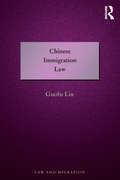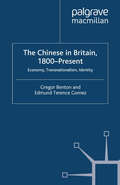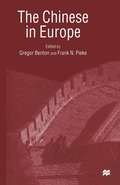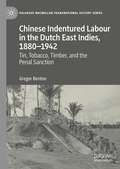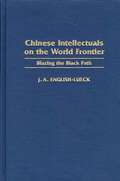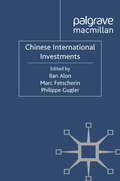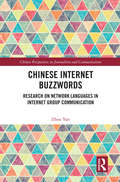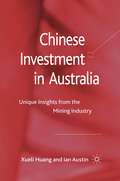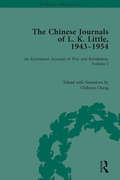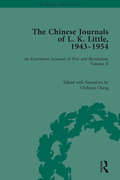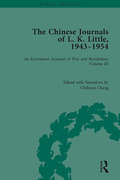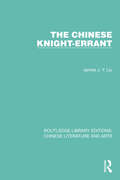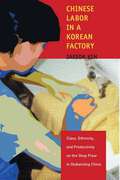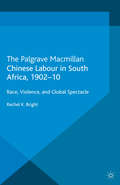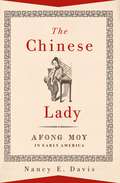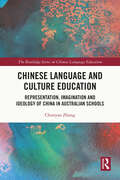- Table View
- List View
Chinese Immigration Law
by Guofu LiuLacking a single immigration code, Chinese immigration law is widespread, encompassing a variety of laws, regulations and policies, some of which are internal and closed. There is also no immigration cases system. These factors have combined to make the study and understanding of the system difficult for those outside or unfamiliar with this area of Chinese law. To add to this complexity, since the reform and opening-up policy in 1978, Chinese immigration law has been experiencing significant change. In particular, that brought about by the acceptance of a market economy in 1991, and with access to World Trade Organization membership in 2001. Due to the dilation of the legislation, the issue of conflict between Chinese immigration law and other Chinese laws has become serious. This book provides a comprehensive, up-to-date, and readily-accessible reference to Chinese immigration law. It provides the necessary detail, insight and background information for a thorough understanding of this complex system. The book has been written on the basis of Chinese statutes while also including coverage of the relevant international instruments. The work draws on and compares Chinese and English language sources, making it an invaluable resource for both Chinese and non-Chinese readers alike.
The Chinese in Britain, 1800-Present: Economy, Transnationalism, Identity (Palgrave Macmillan Transnational History Series)
by G. Benton E. GomezThis study points up the complex interplay of ethnic and national identities in the lives of Chinese in Britain, arguing that transnational studies reinforce essentialist conceptions of identity and cultural authenticity in diasporic communities, and thus frustrate the promotion of ethnic co-existence and social cohesion in multi-ethnic societies.
The Chinese in Europe
by Gregor Benton Frank N. PiekeThe Chinese are among Europe's oldest immigrant communities, and are now, in several countries, among the biggest and, economically, the most powerful, drawing increasing interest from other ethnic minorities, governments, and researchers. This volume opens up and delineates this new field of European overseas Chinese studies, reporting on pioneering research on the Chinese in Britain, Denmark, France, Germany, Hungary, Italy, the Netherlands, Portugal, and Spain, and exploring the networks, self-organizations, and migration patterns that are the fabric of the Chinese community in Europe, together with the issues of identity, language, integration, and community building that Chinese throughout the continent face.
Chinese Indentured Labour in the Dutch East Indies, 1880–1942: Tin, Tobacco, Timber, and the Penal Sanction (Palgrave Macmillan Transnational History Series)
by Gregor BentonThis book offers a comprehensive account of indentured Chinese labour in the Dutch East Indies between 1880 and 1942, particularly in its twilight years after 1917. The author shows that Chinese indenture started and evolved differently from other forms of bonded labour in Southeast Asia and globally, including its Indian and Javanese variants. This difference is reflected in its lexicon, which was in part special to the Chinese strain. Using fieldwork findings from the tin islands of Bangka and Belitung and the Deli plantations on Sumatra as well as archival materials in Dutch, Chinese, and other languages held in libraries in Java, Nanjing, Taipei, Hong Kong, and Leiden, this book presents cutting-edge research that sets out to contribute to the revising of our historical understanding of indenture.
Chinese Intellectuals on the World Frontier: Blazing the Black Path
by J. A. English-LueckThis is the study of the status of intellectuals in the People's Republic of China during and after the events of Tiananmen Square. Currently intellectuals find themselves on the cusp of change as the socialist state monopoly on academia, scientific and technical research is yielding to market pressures. Universities must be, at least partially, self-sustaining. Entrepreneurial niches, outside of state control, are opening for intellectuals as industry privatizes. The entire society has shifted its focus from ideology to material wealth. These dramatic changes have forced choices on China's thought workers. English-Lueck, in conducting over a hundred interviews, highlights the choices and constraints of nonestablishment Chinese intellectuals at the end of the 20th century as they establish a new identity for themselves, and perhaps even for China.
Chinese International Investments
by Ilan Alon Marc FetscherinThis book provides authoritative academic and professional insights into the strategies of Chinese Foreign Direct Investments in Europe, Asia, Africa and the Americas. Distinguished authors from across the world will make a contribution to the growing literature on OFDI (outward foreign direct investment) from China.
Chinese Internet Buzzwords: Research on Network Languages in Internet Group Communication (Chinese Perspectives on Journalism and Communication)
by Zhou YanAs the Internet has reshaped the way we communicate, people’s reading has become more fragmented and attention has been directed to a more concise and general form of language that outlines the most important information. This language of the internet, a language system that concentrates on the content of events and public emotions, has emerged and received wide currency. This monograph is one of the first books to examine the language of the internet in the Chinese context. By analysing content and discourse, the author examines Chinese website buzzwords since 2010. She reveals the mechanisms of generation, the cultural nature and political characteristics of the network language, analyzes the causes of its emergence and popularity, and highlights its social and academic significance. Meanwhile, she argues that research in the area is essentially interdisciplinary, involving not only perspectives from Journalism and Communication Studies, but also Philosophy, Culture, Linguistics and Sociology. Students and scholars of Communication Studies and Journalism, as well as Culture Studies should be greatly interested in this title.
Chinese Internet Buzzwords: Research on Network Languages in Internet Group Communication (Chinese Perspectives on Journalism and Communication)
by Zhou YanAs the Internet has reshaped the way we communicate, people’s reading has become more fragmented and attention has been directed to a more concise and general form of language that outlines the most important information. This language of the internet, a language system that concentrates on the content of events and public emotions, has emerged and received wide currency. This monograph is one of the first books to examine the language of the internet in the Chinese context. By analysing content and discourse, the author examines Chinese website buzzwords since 2010. She reveals the mechanisms of generation, the cultural nature and political characteristics of the network language, analyzes the causes of its emergence and popularity, and highlights its social and academic significance. Meanwhile, she argues that research in the area is essentially interdisciplinary, involving not only perspectives from Journalism and Communication Studies, but also Philosophy, Culture, Linguistics and Sociology. Students and scholars of Communication Studies and Journalism, as well as Culture Studies should be greatly interested in this title.
Chinese Investment in Australia: Unique Insights from the Mining Industry
by X. Huang I. AustinThis book provides comprehensive coverage on the key issues of Chinese investment in the Australian minerals industry. It offers unique insights into the entry process, the management of Chinese investments, and their success factors and lessons learnt as being impacted upon by the entangling of political, economic, social and competitive forces.
Chinese Islam: Models of Interaction with State and Society (Global Islamic Cultures)
by Nasr M. Arif Shaojin ChaiThis book explores the fascinating and complex histories of Islam and China. Meticulously researched and captivating, it provides a comprehensive history of the encounters and relationship between these two great civilizations, as well as the unique development and indigenization of Islam within China.The work looks at the early interactions between Arab Muslim traders and the Tang dynasty in the 7th century, shedding light on the establishment of the first Muslim communities in China. The narrative then progresses through subsequent dynasties, examining the ebbs and flows of Muslim influence, integration, and indigenization. It looks at the emergence of the Hui and other Muslim ethnic groups, who play a central role in the story of Chinese Islam. By delving into their customs, beliefs, and distinctive practices, the authors unveil the intricate process of indigenization, where Islam becomes deeply rooted in Chinese culture and society. One of the unique features of this collection is the nuanced analysis of the impact of major political events as well as gradual social changes on the process of adoption and transmission of Islam in China. The authors also highlight the role of economic activities, Chinese Islamic scholars, and key architectural landmarks in this multifaceted history.Part of the Global Islamic Culture series that looks at integrated and indigenized Islam, this book will be of interest to students and researchers of religion, Islamic studies, religious history, political Islam, cultural studies, Islamic law and Asian studies. It will also be useful to readers who are interested in world religions, theology and cultures.
Chinese Islam: Models of Interaction with State and Society (Global Islamic Cultures)
This book explores the fascinating and complex histories of Islam and China. Meticulously researched and captivating, it provides a comprehensive history of the encounters and relationship between these two great civilizations, as well as the unique development and indigenization of Islam within China.The work looks at the early interactions between Arab Muslim traders and the Tang dynasty in the 7th century, shedding light on the establishment of the first Muslim communities in China. The narrative then progresses through subsequent dynasties, examining the ebbs and flows of Muslim influence, integration, and indigenization. It looks at the emergence of the Hui and other Muslim ethnic groups, who play a central role in the story of Chinese Islam. By delving into their customs, beliefs, and distinctive practices, the authors unveil the intricate process of indigenization, where Islam becomes deeply rooted in Chinese culture and society. One of the unique features of this collection is the nuanced analysis of the impact of major political events as well as gradual social changes on the process of adoption and transmission of Islam in China. The authors also highlight the role of economic activities, Chinese Islamic scholars, and key architectural landmarks in this multifaceted history.Part of the Global Islamic Culture series that looks at integrated and indigenized Islam, this book will be of interest to students and researchers of religion, Islamic studies, religious history, political Islam, cultural studies, Islamic law and Asian studies. It will also be useful to readers who are interested in world religions, theology and cultures.
The Chinese Journals of L.K. Little, 1943–54: An Eyewitness Account of War and Revolution, Volume I (The Making of Modern China)
by Chihyun ChangLester Knox Little kept a detailed journal of his time in China and Taiwan. Covering the years 1943 to 1954 it provides important new insights about some of the most dramatic episodes in China’s mid-twentieth century history: Sino-Japanese military and economic competition, China’s domestic political struggle between the Nationalist Party (Kuomintang) and the Chinese Communist Party, and the post-war/Cold War balance of power in Southeast and East Asia. It also contains rich first-hand materials for understanding conditions in Chongqing and post-war Shanghai, the last years of the Republic of China on the Chinese mainland and its early years in Taiwan, and a new inner history of his beloved Chinese Maritime Customs Service. Little’s account, with his insightful comments and explicit descriptions, provides us with a continuous record from the viewpoint of a capable American citizen in Chinese employ who felt responsible for his Chinese and foreign colleagues and for the modernisation of ‘Free China’, as well as allowing a unique insight into the heart of government during a time of intense social and political change. In addition to the original texts, this edition includes extensive explanatory notes providing detailed contextual information regarding the people and places mentioned.
The Chinese Journals of L.K. Little, 1943–54: An Eyewitness Account of War and Revolution, Volume II (The Making of Modern China)
by Chihyun ChangLester Knox Little kept a detailed journal of his time in China and Taiwan. Covering the years 1943 to 1954 it provides important new insights about some of the most dramatic episodes in China’s mid-twentieth century history: Sino-Japanese military and economic competition, China’s domestic political struggle between the Nationalist Party (Kuomintang) and the Chinese Communist Party, and the post-war/Cold War balance of power in Southeast and East Asia. It also contains rich first-hand materials for understanding conditions in Chongqing and post-war Shanghai, the last years of the Republic of China on the Chinese mainland and its early years in Taiwan, and a new inner history of his beloved Chinese Maritime Customs Service. Little’s account, with his insightful comments and explicit descriptions, provides us with a continuous record from the viewpoint of a capable American citizen in Chinese employ who felt responsible for his Chinese and foreign colleagues and for the modernisation of ‘Free China’, as well as allowing a unique insight into the heart of government during a time of intense social and political change. In addition to the original texts, this edition includes extensive explanatory notes providing detailed contextual information regarding the people and places mentioned.
The Chinese Journals of L.K. Little, 1943–54: An Eyewitness Account of War and Revolution, Volume III (The Making of Modern China)
by Chihyun ChangLester Knox Little kept a detailed journal of his time in China and Taiwan. Covering the years 1943 to 1954 it provides important new insights about some of the most dramatic episodes in China’s mid-twentieth century history: Sino-Japanese military and economic competition, China’s domestic political struggle between the Nationalist Party (Kuomintang) and the Chinese Communist Party, and the post-war/Cold War balance of power in Southeast and East Asia. It also contains rich first-hand materials for understanding conditions in Chongqing and post-war Shanghai, the last years of the Republic of China on the Chinese mainland and its early years in Taiwan, and a new inner history of his beloved Chinese Maritime Customs Service. Little’s account, with his insightful comments and explicit descriptions, provides us with a continuous record from the viewpoint of a capable American citizen in Chinese employ who felt responsible for his Chinese and foreign colleagues and for the modernisation of ‘Free China’, as well as allowing a unique insight into the heart of government during a time of intense social and political change. In addition to the original texts, this edition includes extensive explanatory notes providing detailed contextual information regarding the people and places mentioned.
The Chinese Journals of L.K. Little, 1943–54: An Eyewitness Account of War and Revolution, Volume II (The Making of Modern China)
by Chihyun ChangLester Knox Little kept a detailed journal of his time in China and Taiwan. Covering the years 1943 to 1954 it provides important new insights about some of the most dramatic episodes in China’s mid-twentieth century history: Sino-Japanese military and economic competition, China’s domestic political struggle between the Nationalist Party (Kuomintang) and the Chinese Communist Party, and the post-war/Cold War balance of power in Southeast and East Asia. It also contains rich first-hand materials for understanding conditions in Chongqing and post-war Shanghai, the last years of the Republic of China on the Chinese mainland and its early years in Taiwan, and a new inner history of his beloved Chinese Maritime Customs Service. Little’s account, with his insightful comments and explicit descriptions, provides us with a continuous record from the viewpoint of a capable American citizen in Chinese employ who felt responsible for his Chinese and foreign colleagues and for the modernisation of ‘Free China’, as well as allowing a unique insight into the heart of government during a time of intense social and political change. In addition to the original texts, this edition includes extensive explanatory notes providing detailed contextual information regarding the people and places mentioned.
The Chinese Journals of L.K. Little, 1943–54: An Eyewitness Account of War and Revolution, Volume III (The Making of Modern China)
by Chihyun ChangLester Knox Little kept a detailed journal of his time in China and Taiwan. Covering the years 1943 to 1954 it provides important new insights about some of the most dramatic episodes in China’s mid-twentieth century history: Sino-Japanese military and economic competition, China’s domestic political struggle between the Nationalist Party (Kuomintang) and the Chinese Communist Party, and the post-war/Cold War balance of power in Southeast and East Asia. It also contains rich first-hand materials for understanding conditions in Chongqing and post-war Shanghai, the last years of the Republic of China on the Chinese mainland and its early years in Taiwan, and a new inner history of his beloved Chinese Maritime Customs Service. Little’s account, with his insightful comments and explicit descriptions, provides us with a continuous record from the viewpoint of a capable American citizen in Chinese employ who felt responsible for his Chinese and foreign colleagues and for the modernisation of ‘Free China’, as well as allowing a unique insight into the heart of government during a time of intense social and political change. In addition to the original texts, this edition includes extensive explanatory notes providing detailed contextual information regarding the people and places mentioned.
The Chinese Journals of L.K. Little, 1943–54: An Eyewitness Account of War and Revolution, Volume I (The Making of Modern China)
by Chihyun ChangLester Knox Little kept a detailed journal of his time in China and Taiwan. Covering the years 1943 to 1954 it provides important new insights about some of the most dramatic episodes in China’s mid-twentieth century history: Sino-Japanese military and economic competition, China’s domestic political struggle between the Nationalist Party (Kuomintang) and the Chinese Communist Party, and the post-war/Cold War balance of power in Southeast and East Asia. It also contains rich first-hand materials for understanding conditions in Chongqing and post-war Shanghai, the last years of the Republic of China on the Chinese mainland and its early years in Taiwan, and a new inner history of his beloved Chinese Maritime Customs Service. Little’s account, with his insightful comments and explicit descriptions, provides us with a continuous record from the viewpoint of a capable American citizen in Chinese employ who felt responsible for his Chinese and foreign colleagues and for the modernisation of ‘Free China’, as well as allowing a unique insight into the heart of government during a time of intense social and political change. In addition to the original texts, this edition includes extensive explanatory notes providing detailed contextual information regarding the people and places mentioned.
The Chinese Knight-Errant (Routledge Library Editions: Chinese Literature and Arts #8)
by James J.Y. LiuThis book, first published in 1967, is a comprehensive study of knight-errantry in Chinese history and literature from the fourth century BC to the twentieth century. After discussing the social and intellectual backgrounds of knight-errantry, it gives examples of historical knights and describes the development of the theme of knight-errantry in poetry, fiction and drama. Many biographies, anecdotes, poems and tales are translated in full, while long prose romances and dramatic works are summarized and discussed. As background to these, sketches of the developments of Chinese fiction and drama are provided. In a final chapter, comparisons are made between Chinese and European knights, and between Chinese and Western chivalric literature.
The Chinese Knight-Errant (Routledge Library Editions: Chinese Literature and Arts #8)
by James J.Y. LiuThis book, first published in 1967, is a comprehensive study of knight-errantry in Chinese history and literature from the fourth century BC to the twentieth century. After discussing the social and intellectual backgrounds of knight-errantry, it gives examples of historical knights and describes the development of the theme of knight-errantry in poetry, fiction and drama. Many biographies, anecdotes, poems and tales are translated in full, while long prose romances and dramatic works are summarized and discussed. As background to these, sketches of the developments of Chinese fiction and drama are provided. In a final chapter, comparisons are made between Chinese and European knights, and between Chinese and Western chivalric literature.
Chinese Labor in a Korean Factory: Class, Ethnicity, and Productivity on the Shop Floor in Globalizing China
by Jaesok KimChinese Labor in a Korean Factorydraws on fieldwork in a multinational corporation (MNC) in Qingdao, China, and delves deep into the power dynamics at play between Korean management, Chinese migrant workers, local-level Chinese government officials, and Chinese local gangs. Anthropologist Jaesok Kim examines how governments, to attract MNCs, relinquish parts of their legal rights over these entities, while MNCs also give up portions of their rights as proxies of global capitalism by complying with local government guidelines to ensure infrastructure and cheap labor. This ethnography demonstrates how a particular MNC struggled with the pressure to be increasingly profitable while negotiating the clash of Korean and Chinese cultures, traditions, and classes on the factory floor of a garment corporation. Chinese Labor in a Korean Factory pays particular attention to common features of post-socialist countries. By analyzing the contentious collaboration between foreign management, factory workers, government officials, and gangs, this study contributes not only to the research on the politics of resistance but also to how global and local forces interact in concrete and surprising ways.
Chinese Labour in South Africa, 1902-10: Race, Violence, and Global Spectacle (Cambridge Imperial and Post-Colonial Studies)
by R. BrightThis book explores the decision of the British Empire to import Chinese labour to southern Africa despite the already tense racial situation in the region. It enables a clearer understanding of racial and political developments in southern Africa during the reconstruction period and places localised issues within a wider historiography.
The Chinese Lady: Afong Moy in Early America
by Nancy E. DavisIn 1834, a young Chinese woman named Afong Moy arrived in America, her bound feet stepping ashore in New York City. She was both a prized guest and advertisement for a merchant firm--a promotional curiosity used to peddle exotic wares from the East. Over the next few years, she would shape Americans' impressions of China even as she assisted her merchant sponsors in selling the largest quantities of Chinese goods yet imported for the burgeoning American market. Americans views of the exotic Far East in this early period before Chinese immigration were less critical than they would later become. Afong Moy became a subject of poetry, a trendsetter for hair styles and new fashions, and a lucky name for winning racehorses. She met Americans face to face in cities and towns across the country, appearing on local stages to sell and to entertain. Yet she also moved in high society, and was the first Chinese guest to be welcomed to the White House. However, this success was not to last. As her novelty wore off, Afong Moy was cast aside by her managers. Though concerned public citizens rallied in support, her fame dwindled and she spent several years in a New Jersey almshouse. In the late 1840s, P.T. Barnum offered Afong Moy several years of promising renewal as the compatriot of Tom Thumb, yet this stint too was short-lived. In this first biography, Nancy E. Davis sheds light on the mystery of Afong Moy's life as a Chinese woman living in a foreign land.
The Chinese Lady: Afong Moy in Early America
by Nancy E. DavisIn 1834, a young Chinese woman named Afong Moy arrived in America, her bound feet stepping ashore in New York City. She was both a prized guest and advertisement for a merchant firm--a promotional curiosity used to peddle exotic wares from the East. Over the next few years, she would shape Americans' impressions of China even as she assisted her merchant sponsors in selling the largest quantities of Chinese goods yet imported for the burgeoning American market. Americans views of the exotic Far East in this early period before Chinese immigration were less critical than they would later become. Afong Moy became a subject of poetry, a trendsetter for hair styles and new fashions, and a lucky name for winning racehorses. She met Americans face to face in cities and towns across the country, appearing on local stages to sell and to entertain. Yet she also moved in high society, and was the first Chinese guest to be welcomed to the White House. However, this success was not to last. As her novelty wore off, Afong Moy was cast aside by her managers. Though concerned public citizens rallied in support, her fame dwindled and she spent several years in a New Jersey almshouse. In the late 1840s, P.T. Barnum offered Afong Moy several years of promising renewal as the compatriot of Tom Thumb, yet this stint too was short-lived. In this first biography, Nancy E. Davis sheds light on the mystery of Afong Moy's life as a Chinese woman living in a foreign land.
Chinese Language and Culture Education: Representation, Imagination and Ideology of China in Australian Schools (The Routledge Series on Chinese Language Education)
by Chunyan ZhangAgainst the background of the Australian government’s strategic plan to promote Asian languages in schools, this book is an innovative autoethnographic inquiry into what actually occurs in the implementation of a Chinese language and culture program in an Australian context.Drawing on eight years of socio-cultural and educational fieldwork in a primary school, Chunyan Zhang examines complex, fluid and heterogeneous daily teaching practices and the ways in which ideas of China are assembled, presented and performed. She asks the following questions: What is China? Where does Taiwan fit into the China depicted in a multicultural, globalised classroom? Can Chinese communism or Chairman Mao be avoided in teaching English-speaking learners? What kind of China is brought in here while what kind of China is being silenced and othered? Through the partial connection between method assemblage and Daoist concepts, Zhang develops a water-like pedagogy in teaching. She uses the knowledge flow model to examine the imbalanced knowledge flow within teacher-student interactions. From finding China as a hybrid assemblage to proposing China as method, Zhang’s investigation makes an important contribution to the sociology of Chinese language education.This book is an essential and rich content resource for primary and secondary teacher education and research, teacher candidates and educators in Chinese as a second language education.
Chinese Language and Culture Education: Representation, Imagination and Ideology of China in Australian Schools (The Routledge Series on Chinese Language Education)
by Chunyan ZhangAgainst the background of the Australian government’s strategic plan to promote Asian languages in schools, this book is an innovative autoethnographic inquiry into what actually occurs in the implementation of a Chinese language and culture program in an Australian context.Drawing on eight years of socio-cultural and educational fieldwork in a primary school, Chunyan Zhang examines complex, fluid and heterogeneous daily teaching practices and the ways in which ideas of China are assembled, presented and performed. She asks the following questions: What is China? Where does Taiwan fit into the China depicted in a multicultural, globalised classroom? Can Chinese communism or Chairman Mao be avoided in teaching English-speaking learners? What kind of China is brought in here while what kind of China is being silenced and othered? Through the partial connection between method assemblage and Daoist concepts, Zhang develops a water-like pedagogy in teaching. She uses the knowledge flow model to examine the imbalanced knowledge flow within teacher-student interactions. From finding China as a hybrid assemblage to proposing China as method, Zhang’s investigation makes an important contribution to the sociology of Chinese language education.This book is an essential and rich content resource for primary and secondary teacher education and research, teacher candidates and educators in Chinese as a second language education.
